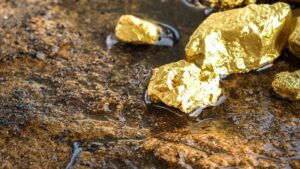Monsters of Rock: WA’s labour shortages have gold sector nervous about growth

It's hard to find good workers these days. Pic: John Lund/Stone via Getty Images
- Black Cat Syndicate becomes the latest gold miner to defer construction plans as labour shortages in WA bite
- The company says its Kal East gold project would produce over 300,000oz of gold over 5.5 years
- Capital Economics economists say mining output could halve as a proportion of Australian GDP by 2050
There is no shortage of junior gold miners looking to start up new operations around the WA Goldfields.
However, companies like Black Cat Syndicate (ASX:BC8) are in a bit of a bind.
Black Cat has 242,900oz of delectable looking gold reserves sitting in deposits around the old Bulong gold field to the east of Kalgoorlie, somewhat prosaically titled the Kal East Gold Project.
But it doesn’t have the people to go out and build the the damn thing.
“Recent mining cost increases have been factored into the Study capital and operating costs and Kal East remains highly competitive against other operating WA gold operations,” BC8 MD Gareth Solly said.
“The company has deferred the decision to build the Kal East processing facility until labour availability conditions improve and allow construction to commence.”
There are few options when it comes to mills nearby.
Toronto-listed Karora Resources, owner of the Beta Hunt gold mine, recently paid a whopping $80 million to buy the Lakewood toll treatment plant south of the Super Pit from privately owned Golden Mile Milling, which had picked up the asset for peanuts from Silver Lake during the downturn a few years earlier.
A ‘base case’ PFS study showed the mine would deliver total production of 301,700oz over 5.5 years at an average rate of 56,000oz per annum at AISC of $1510/oz with a pre-production capital drawdown of $82.7m.
But Black Cat, co-founded by former Silver Lake Resources (ASX:SLR) supremos Paul Chapman and Les Davis, says it will now use the opportunity to improve on Kal East, including bolstering ore reserves from its 1.3Moz resource.
The Myhree/Boundary deposits could be developed as toll treatment starter projects early to generate cash flow.
WA’s employment conundrum
Its attention will also turn to restart plans for the Paulsens and Coyote operations traded in a combined $44.5m deal by Northern Star Resources (ASX:NST). Those deposits boast a respective 271,000oz and 488,000oz resource base at economic mining grades, with $140 million of infrastructure investment already sunk by previous owners.
“The in-situ high-grade Resources at each project have the potential to deliver rapid cashflow due to the anticipated low capital restart costs,” Solly said. “Black Cat is working towards a five-year vision and plan to have all three of our operations producing gold.”
Black Cat is not the first company to complain about WA’s issues with attracting labour, something which will take a while to ease given WA’s local unemployment rate is just 2.9%, far below the already tightly strung 3.9% national rate.
Competition for skilled mine workers remains fierce. Black Cat’s neighbour Silver Lake suddenly withdrew its guidance in its recent March quarterly report due to the unpredictability wrought by Covid-19.
WA miners, drillers and contractors are offering crazy rates for greenhorns, with jobs requiring no experience heading into six figures.
Ramelius Resources (ASX:RMS) boss Mark Zeptner in April noted the difficulty his company — a 250,000ozpa gold miner — was having securing shutdown workers, saying there were stories of them getting poached for other jobs on higher pay within weeks, days and hours of them heading to site.
Last year Bardoc Gold (ASX:BDC) also abruptly shelved plans to develop its project of the same name to the north of Kalgoorlie last year, opting instead to be taken over by established gold miner St Barbara (ASX:SBM) after citing higher than expected costs from inflation.
Black Cat Syndicate (ASX:BC8) share price today:
Is mining over?
It’s a question answered easier with statistics than in the real world.
Capital Economics senior Japan, Australia and New Zealand economist Marcel Thieliant has made the call, saying mining output could fall to just 5% of GDP by 2050 amid global pressure to decarbonise.
In the evidence locker is falling investment in mining developments, with the 2.6% share of GDP spent in the March quarter almost only a little over a quarter of the peak of 9.5% set in the mining boom.
At 9.9% in the March quarter Thieliant notes mining output as a share of GDP has dropped from 11.5% at the height of the pandemic and is at its lowest level since 2015. That came despite the terms of trade hitting record highs recently and mining accounting for more than half of corporate profits for the first time last quarter.
The shift of the GDP balance towards services, which hit a record high of 62.7% in March could get starker.
“We think that efforts to decarbonise the global economy will result in mining accounting for just 5% of GDP by 2050,” he said.
“The impact is already visible: while gas and iron ore output have only fallen modestly from their peak in 2020, coal mining has plunged by nearly 20%.”
That’s a problem for this and successive Federal Governments, who may need to tighten the belt according to Thieliant given each employee added in mining generates six times as much output as workers in other sectors.
“An expansion in government spending, which jumped yet again in Q1, has kept the economy afloat even as the mining sector is starting to shrink,” he said.
“Since 2019, the share of government spending in GDP has jumped by nearly 3%-pts. But that can’t continue forever.
“As such, the new Labor government has its work cut out to improve the long-run prospects for Australia’s economy.”
There are some caveats not mentioned by Thieliant when it comes to the recent dive in mining output.
Covid hit WA for the first time in the March quarter, crimping output in iron ore, gold and lithium among other key sectors, whereas those mines operated virtually unabated while other sectors like hospitality and travel faltered during last year’s east coast lockdowns.
Wet weather also hit coal miners and other diggers on the east coast.
In terms of economic problems that are here right now, with inflation rampant CapEc is expecting a further 25bp increase in interest rates at the RBA’s June meeting on Tuesday.
Related Topics

UNLOCK INSIGHTS
Discover the untold stories of emerging ASX stocks.
Daily news and expert analysis, it's free to subscribe.
By proceeding, you confirm you understand that we handle personal information in accordance with our Privacy Policy.








